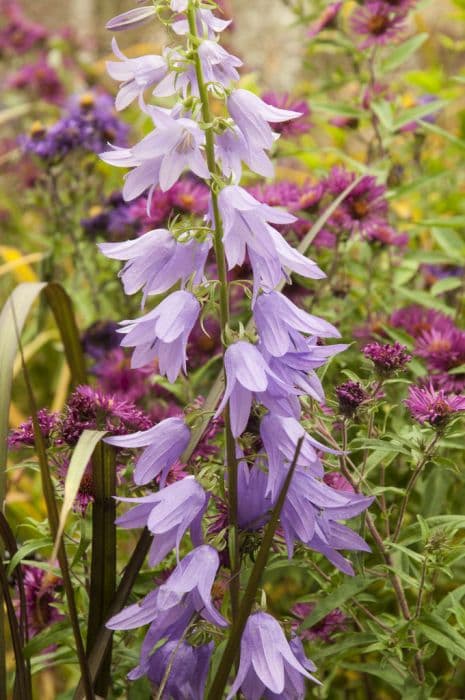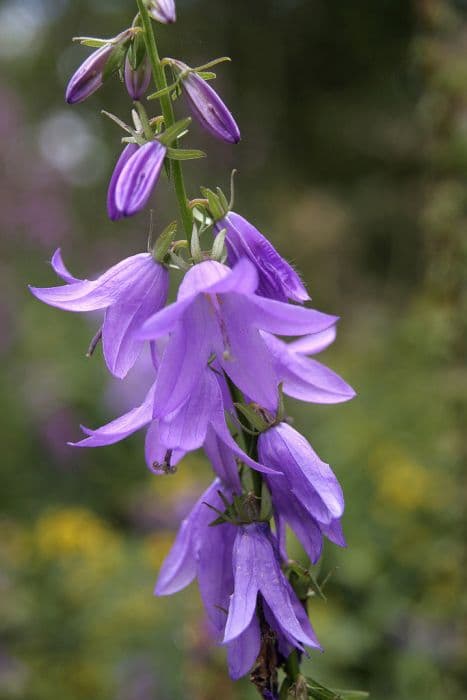Balloon Flower Platycodon grandiflorus 'Mariesii'

ABOUT
The Platycodon grandiflorus 'Mariesii', commonly known as the balloon flower, is named for its unique flower buds that swell like miniature balloons before opening. Its flowers boast a striking blue coloration, though they may sometimes vary with hues of pink or white. The petals are broad and exhibit a star-shaped form when fully open, carrying a delicate and appealing aesthetic. The foliage of the balloon flower is a lush green, consisting of lance-shaped leaves that provide a verdant backdrop for the vivid blooms. This contrast between the vibrant blossoms and the green leaves makes the balloon flower a standout addition to any garden where it is planted. The plant typically blooms in the summer months, offering a lengthy season of visual interest with its colorful and distinctive flowers.
About this plant
 Names
NamesFamily
Campanulaceae
Synonyms
Balloon Flower, Chinese Bellflower, Japanese Bellflower, Dwarf Balloon Flower, Blue Balloon Flower, Mariesii Balloon Flower
Common names
Campanula grandiflora, Campanula glauca, Platycodon glaucus.
 Toxicity
ToxicityTo humans
Balloon flower (Platycodon grandiflorus 'Mariesii') is generally not considered toxic to humans. There is no well-documented evidence of the plant causing significant poisoning when ingested. As with any plant, individual allergic reactions or sensitivity to balloon flower could occur; therefore, it is not advisable to consume parts of this plant without proper knowledge and identification.
To pets
Balloon flower (Platycodon grandiflorus 'Mariesii') is not commonly listed as toxic to pets such as cats and dogs. There are no specific symptoms of poisoning associated with this plant, as it is generally considered non-toxic. However, ingestion of any non-food plant material can potentially cause gastrointestinal upset in pets, so it is advisable to prevent pets from consuming this plant to avoid any potential discomfort.
 Characteristics
CharacteristicsLife cycle
Perennials
Foliage type
Deciduous
Color of leaves
Green
Flower color
Blue
Height
1 feet 10-24 inches (30-60 cm)
Spread
1 feet 10-24 inches (30-60 cm)
Plant type
Herb
Hardiness zones
3
Native area
East Asia
Benefits
 General Benefits
General Benefits- Ornamental Value: Platycodon grandiflorus 'Mariesii', commonly known as Balloon Flower, features showy, balloon-shaped buds that open into beautiful star-shaped flowers, adding aesthetic appeal to gardens.
- Attracts Pollinators: The vibrant flowers attract bees, butterflies, and other beneficial pollinators, which are essential for pollinating gardens and supporting biodiversity.
- Drought Tolerance: Once established, Balloon Flowers have good drought tolerance, making them suitable for gardens in areas with occasional water restrictions.
- Low Maintenance: The plant is relatively low maintenance, requiring minimal care once it has taken root, which is ideal for gardeners looking for easy-to-care-for plants.
- Cold Hardy: It is cold hardy and can survive in cooler climates, which makes it a robust addition to many gardens in temperate regions.
 Medical Properties
Medical Properties- Anti-inflammatory: Platycodon grandiflorus 'Mariesii', commonly known as Balloon Flower, has been used in traditional medicine to reduce inflammation.
- Expectorant: It is traditionally used to help in the expulsion of phlegm from the respiratory tract.
- Antitussive: Balloon Flower has been used to suppress cough.
- Immunomodulatory: Some research suggests potential benefits in modulating immune system responses.
- Sore throat remedy: It has been used historically to soothe sore throats.
- Ulcer protection: Balloon Flower may be involved in protecting against or healing gastric ulcers.
 Air-purifying Qualities
Air-purifying QualitiesThis plant is not specifically known for air purifying qualities.
 Other Uses
Other Uses- Culinary garnish: The distinctive star-shaped flowers of the Balloon Flower can be used to decorate salads and desserts, adding a splash of color and a mild, slightly peppery flavor.
- Crafting natural dyes: The roots of the Balloon Flower can be used to produce a blue or gray dye for fabrics and yarns, available through traditional dyeing techniques.
- Bioindicator: The Balloon Flower can act as a bioindicator for soil health, as it prefers well-drained soil and may not thrive in poorly drained areas, indicating potential soil issues.
- Children's education: This plant's unique balloon-like buds before blooming can serve as an educational tool, demonstrating plant growth and development to children.
- Horticultural therapy: As an easy-to-grow perennial, the Balloon Flower can be used in therapeutic gardening programs, helping individuals to develop nurturing skills and reduce stress.
- Floral arrangements: Dried balloon flower stems can be used in floral arrangements, providing structure and interest with their pod-like capsules post-bloom.
- Photography subject: Due to its vivid bloom color and unique bud shape, the Balloon Flower is an excellent subject for botanical photography, ideal for those practicing macro photography.
- Fairy gardens: The whimsical shape of the Balloon Flower makes it a popular choice for creating miniature fairy garden landscapes, which often use plants to create scenes of enchantment.
- Companion planting: The Balloon Flower can be planted alongside vegetables like tomatoes to improve aesthetic appeal in the garden without competing for resources.
- Seed harvesting: Enthusiastic gardeners can harvest seeds from the Balloon Flower to exchange with others or to grow new plants, as a way of preserving plant diversity.
Interesting Facts
 Feng Shui
Feng ShuiThe Balloon Flower is not used in Feng Shui practice.
 Zodiac Sign Compitability
Zodiac Sign CompitabilityThe Balloon Flower is not used in astrology practice.
 Plant Symbolism
Plant Symbolism- Endurance and Strength: The Platycodon grandiflorus 'Mariesii', commonly known as 'Balloon Flower', often symbolizes endurance and strength due to its hardy nature and ability to withstand various environments.
- Unfolding of Wishes: Its name 'Balloon Flower' comes from the way the flower buds puff up like balloons before opening, representing the unfolding of wishes and the manifestation of dreams.
- Purity and Cleansing: The striking blue color of the Balloon Flower is also associated with purity and cleansing, suggesting a sense of serenity and clarity.
- Eternal Love: In some cultures, the Balloon Flower is believed to symbolize eternal love or a love that transcends time and space, likely due to its long-lasting blooms.
 Water
WaterBalloon flower (Platycodon grandiflorus 'Mariesii') should be watered deeply, allowing the soil to be moist but not waterlogged. During the growing season, watering once a week with approximately one gallon of water per plant is sufficient. However, frequency should be adjusted depending on weather conditions; more water may be necessary during hot, dry periods and less during rainy spells. Allow the top inch of soil to dry out between waterings to encourage strong root development. Overwatering or poor drainage can lead to root rot, so ensure good soil aeration.
 Light
LightBalloon flower thrives in full sun to partial shade. The best spot for the plant would be one where it receives at least six hours of sunlight each day. While it can tolerate some shade, too much can lead to leggy growth and fewer blooms. A location with morning sun and afternoon shade is ideal, especially in regions with intense midday sun.
 Temperature
TemperatureBalloon flower prefers temperate climates with temperatures ranging between 60 to 75 degrees Fahrenheit. While it can tolerate a minimum temperature of around 30 degrees Fahrenheit, frost can damage the plant. Ideal growing conditions include warm days and cooler nights, as long as the temperature stays within the above range for optimal growth.
 Pruning
PruningPruning balloon flower involves deadheading spent blooms to encourage further flowering and to maintain plant appearance. It's best to prune in late summer or fall, after the blooming period has ended. Pruning can also include cutting back the plant to within a few inches of the ground in late fall or early spring to promote healthy growth and prevent the plant from becoming too leggy.
 Cleaning
CleaningAs needed
 Soil
SoilBalloon Flower (Platycodon grandiflorus 'Mariesii') thrives in well-draining soil with a mix of loam, peat, and sharp sand. It prefers a slightly acidic to neutral pH between 5.5 and 7.5. An ideal soil mix would be two parts loam, one part peat moss, and one part perlite or sharp sand to ensure good drainage.
 Repotting
RepottingBalloon Flower, also known as Platycodon grandiflorus 'Mariesii', generally requires repotting every 2-3 years. It's best to repot in spring just before new growth starts, allowing the plant to establish in the new pot throughout the growing season.
 Humidity & Misting
Humidity & MistingBalloon Flower (Platycodon grandiflorus 'Mariesii') is tolerant of a wide range of humidity levels but prefers average room humidity, around 40-60%. It does not require any special humidity adjustments when grown in typical home or garden settings.
 Suitable locations
Suitable locationsIndoor
Place in bright, indirect light and ensure good air circulation.
Outdoor
Plant in full sun to partial shade; shelter from strong winds.
Hardiness zone
3-8 USDA
 Life cycle
Life cycleThe life of Platycodon grandiflorus 'Mariesii', commonly known as 'Mariesii' balloon flower, begins with seed germination, which occurs in the spring when the soil has warmed sufficiently. After germination, the seedling develops into a young plant with a rosette of foliage at the soil surface, where the root system establishes itself. As the plant matures, it starts to send up flower stalks, and by mid to late summer, distinctive balloon-like buds form, which eventually open into star-shaped bell-like blue or purple flowers. After flowering, the plant sets seed in pods that, once dried, release seeds for the next generation. In fall, the above-ground part of the plant dies back, while below ground, the plant's roots survive the winter in a dormant state. With the arrival of another spring, the plant emerges from dormancy to start the cycle anew, surviving year to year as a herbaceous perennial.
 Propogation
PropogationPropogation time
Spring-Early Summer
The Balloon Flower, scientifically known as Platycodon grandiflorus 'Mariesii', is typically propagated through seed sowing. The most popular method of propagation for this plant is indeed seed sowing, which is best done in spring after the danger of frost has passed. To propagate balloon flowers by seed, you should start indoors by sowing seeds in a tray filled with a well-draining seed starting mix. Lightly press the seeds into the soil but do not cover them, as they require light for germination. Keep the soil moist but not waterlogged and maintain a temperature around 70 degrees Fahrenheit (21 degrees Celsius). Germination usually occurs within two to three weeks. After seedlings have developed two sets of true leaves and the weather has warmed, they can be transplanted outdoors into well-draining garden soil rich in organic matter, spaced approximately 12 inches (about 30 centimeters) apart to allow for mature growth.








